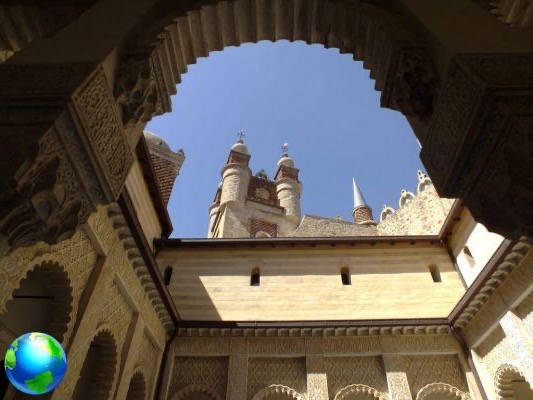Let's get to know a truly original historical figure: Cesare Mattei, the thaumaturge count. With this post, we take you to a town on the Bolognese Apennines: Rocchetta Mattei, where a very particular castle stands out in style and history.
If you want to forget the gray of everyday life, put a weekend on theBolognese Apennines, in Riola Ponte, to visit Rocchetta Mattei and get your fill of exoticism, colors and eclecticism.
Riola Ponte, a town in the Bolognese Apennines not far from Tuscany, reserves a lot of surprises.
The municipality is that of Grizzana Morandi, where I happened to walk along the Via della Lana e della Seta. But on that occasion I hadn't been able to visit Riola's most eccentric monument, Rocchetta Mattei.

Rocchetta Mattei: home of a thaumaturge count
La Rocchetta is the fairytale castle that the Count Cesare Mattei he built during his entire life: it stands on the top of a hill and is an eclectic style building, which can only be visited with guided tour. La Rocchetta was the home of the Count.
This character was a man of letters and one of the founders of the Cassa di Risparmio di Bologna. He acquired an incredible notoriety thanks to his "invention": a medical science called electro homeopathy with which he healed the diseases of people who came from all over the world to be examined and prescribed the prodigious medicines. As you will have understood Cesare Mattei was a character outside the box, so original that he took the secret of electro homeopathy to his grave, not trusting anyone to hand it over. Even the Tsar of Russia arrived in these mountains to be treated by Mattei.

Work on the Rocchetta began in 1850 and accompanied him throughout his life. Even today a part of this curious building is the subject of renovation works. At first the castle had to have a medieval look (complete with towers and battlements), then the Count's taste turned towards style Arabic. La Rocchetta connotes the Riola skyline with golden onion domes and colorful decorations on the external walls.
The trompe l'oeil choices
One of the most curious aspects that are underlined during the guided tour of the Rocchetta are the trompe l'oeil decorative choices, ingenious inventions that deceive the eye and that had to arouse the wonder of the visitors of this place. The first details can already be seen in the entrance courtyard: a balustrade that seems to be made of wooden logs, while in reality it is "scratched" concrete to recreate the effect of the veins.

The play of arches in the ceiling in the chapel which is inspired by the great Cordoba Mosque, but it is very reminiscent of the black and white marble decorations of Italian cathedrals. In reality, approaching the arches reveals the deception: it is painted wood that imitates the much more expensive material. While the apparent inlay of the ceiling ... it is just squares of fabric, hand painted!
And again, in the room where Mattei held his clinic, the ceiling seems to be inlaid with wooden ashlars. One of these "ashlars" placed in a display case at eye level reveals an ingenious workmanship of brown colored papier mache. In short, a continuum postponement of play and deception, of masks behind which to hide the truth, which make this place an intriguing mystery.

Visit
During the visit to the castle one must abandon oneself and be conquered by the continuous contrasts, between statues of antiquity, sphinxes, Arab decorations and fountains, allegorical meanings, majolica, spiral staircases and communicating rooms. It's like being inside a kaleidoscope of styles and colors. The visit must be booked and paid in advance on the rocchetta-mattei.it website.
The groups that are formed are a maximum of 20 people; it can be visited on Saturdays and Sundays from 10 to 15 in the winter and from 9,30 to 13 and from 15 to 17,30 during the summer.

And again, in Riola Ponte
If the Rocchetta has intoxicated you, you can go and "cool down" in the village, in Riola, where you will find the other surprise. I'm talking about the parish church: one of the latest projects by the famous Finnish architect Alvar Aalto, built in the late 70s.
The façade seems to have been designed by a child, but it is enough to enter this harmonious, clear, linear, luminous and serene environment to digest all the oddities that Count Cesare Mattei has given us.
Something very different but equally valuable, with free admission.


























